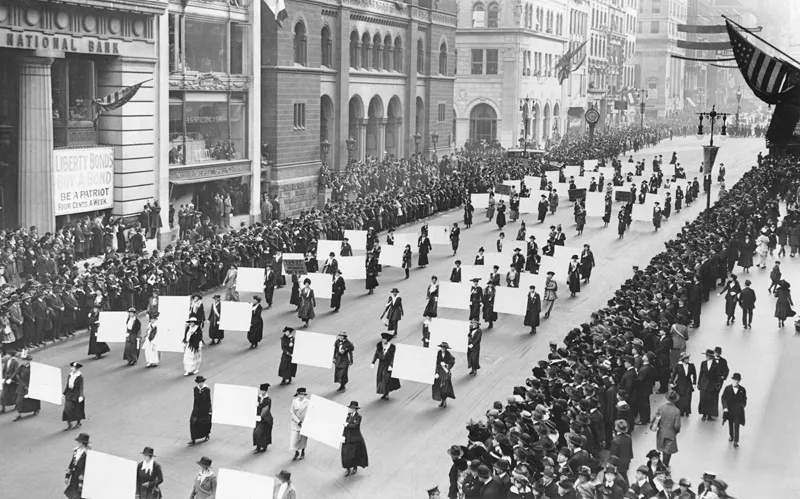Women’s Rights History in the U.S.
March is National Women’s History Month and a time to celebrate and educate. When the U.S. was first established, a woman was considered a man’s property. She was silenced, discriminated against, and deprived of her civil rights. It took decades of persistent work and sacrifice by women’s rights activists to change that.
Check out the video above for a quick 2-minute history lesson on women’s rights in America or explore the whole timeline of women’s rights below.
It’s a reminder that we’ve made tremendous progress, but that there’s still a distance to go!
Complete Timeline History of Women’s Rights
1769 — The early American colonies base their laws on the English common law, which said, “By marriage, the husband and wife are one person in the law. The very being and legal existence of the woman is suspended during the marriage, or at least is incorporated into that of her husband under whose wing and protection she performs everything.”
1777 — All states pass laws taking away women’s right to vote.
1833 — Oberlin College is founded as the first co-educational institution that accepts women and African Americans.
1848 — At Seneca Falls, 300 women and men sign the Declaration of Sentiments, a plea for the end of discrimination against women.
1848 — New York passes the Married Woman’s Property Act. For the first time, a woman isn’t automatically liable for her husband’s debts; she could enter contracts on her own; she could collect rents or receive an inheritance in her own right; she could file a lawsuit on her own behalf. She became for economic purposes, an individual.
1870 — The 15th Amendment is ratified, saying, “The right of citizens of the United States to vote shall not be denied or abridged by the United States or by any State on account of race, color, or previous condition of servitude.” African-Americans may vote now, but women may not.
1872 — Victoria Woodhull becomes the first woman to run for U.S. President. She receives few votes.
1890 — Wyoming becomes the first state to grant women the right to vote in its state elections.
1900 — By now, every state has passed legislation modeled after New York’s Married Women’s Property Act (1848), granting married women some control over their property and earnings.
1918 — Margaret Sanger wins her suit in New York to allow doctors to advise their married patients about birth control for health purposes.
1920 — The 19th Amendment is ratified and grants women the right to vote. It declares: “The right of citizens of the United States to vote shall not be denied or abridged by the United States or by any State on account of sex.”
1922 — Suffragette and activist Rebecca Felton is appointed the first woman U.S. Senator. At 87-years-old, she serves for only two days.
1923 — The National Woman’s Party proposes a Constitutional amendment: “Men and women shall have equal rights throughout the United States and in every place subject to its jurisdiction. Congress shall have power to enforce this article by appropriate legislation.” It does not pass.
1932 — Hattie Wyatt Caraway, of Arkansas, becomes the first woman elected to the U.S. Senate.
1933 —Labor Secretary Frances Perkins is the first woman to serve on a Presidential Cabinet under Franklin D. Roosevelt.
1934 — Lettie Pate Whitehead becomes the first American woman to serve as a director of a major corporation, the Coca-Cola Company.
1936 — Judicial approval of medicinal use of birth control is established.
1937 — The U.S. Supreme Court upholds Washington state’s minimum wage laws for women.
1963 — The Equal Pay Act is passed, promising equitable wages for the same work, regardless of the race, color, religion, national origin or sex of the worker.
1964 — The Civil Rights Act passes, prohibiting discrimination on the basis of race, color, religion, national origin, or sex.
1965 — In Griswold v Connecticut, the Supreme Court overturns one of the last state laws prohibiting the prescription or use of contraceptives by married couples.
1969 — In Bowe v. Colgate-Palmolive Company, the Seventh Circuit Court of Appeals rules that women meeting the physical requirements can work jobs that had been for men only.
1969 — Shirley Chisholm, of New York, becomes the first African-American woman in Congress. Her motto is, “Unbought and unbossed.” She serves in the U.S. House of Representatives for 14 years.
1971 — In Phillips v. Martin Marietta Corporation, the U.S. Supreme Court outlaws the practice of private employers refusing to hire women with pre-school children.
1972 — Title IX of the Education Amendments prohibits sex discrimination in all aspects of education programs that receive federal support.
1972 — In Eisenstadt v. Baird, the Supreme Court rules that the right to privacy encompasses an unmarried person’s right to use contraceptives.
1972 — Katharine Graham becomes the first woman to become CEO of a Fortune 500 company (The Washington Post).
1973 — With its Roe v. Wade decision, the U.S. Supreme Court declares that the Constitution protects women’s right to terminate an early pregnancy, thus making abortion legal in the U.S.
1974 — Housing discrimination on the basis of sex and credit discrimination against women are outlawed by Congress.
1974 — Cleveland Board of Education v. LaFleur determines it is illegal to force pregnant women to take maternity leave on the assumption they are incapable of working in their physical condition.
1974 — The Women’s Educational Equity Act funds the development of nonsexist teaching materials and model programs that encourage full educational opportunities for girls and women.
1974 — The Equal Credit Opportunity Act passes. It does away with the practice of banks requiring single, widowed or divorced women to bring a man along to cosign any credit application.
1975 — In Taylor v. Louisiana, the court denies states the right to exclude women from juries.
1978 — The Pregnancy Discrimination Act bans discrimination against women on the basis of pregnancy, childbirth or related medical issues.
1981 — Sandra Day O’Connor is appointed as the first female U.S. Supreme Court Justice.
1984 — In Roberts v. U.S. Jaycees, sex discrimination in organizational membership policies is forbidden, opening many previously all-male organizations (Jaycees, Kiwanis, Rotary, Lions) to women.
1987 — After being petitioned by the National Women’s History Project, Congress designates March as Women’s History Month.
1994 — Congress adopts the Gender Equity in Education Act to train teachers in gender equity, promote math and science learning by girls, counsel pregnant teens, and prevent sexual harassment.
1994 — The Violence Against Women Act funds services for victims of rape and domestic violence, allows women to seek civil rights remedies for gender-related crimes, provides training to increase police and court officials’ sensitivity and a national 24-hour hotline for battered women.
1996 — Supreme Justice Ruth Bader Ginsburg writes the landmark decision in United States v. Virginia, which held that the state-supported Virginia Military Institute could not refuse to admit women.
1997 — Madeleine Albright is sworn in as U.S. Secretary of State. She is the first woman in this position.
2005 — Condoleezza Rice becomes the first black female Secretary of State.
2007 — Nancy Pelosi becomes the first female Speaker of the House.
2009 — Sonia Sotomayor is becomes the first Hispanic American and the third woman to serve as a U.S. Supreme Court Justice.
2013 — The ban against women in military combat positions is removed; this overturned a 1994 Pentagon decision restricting women from combat roles.
2013 — Reauthorization of the Violence Against Women Act. The new bill extends coverage to women of Native American tribal lands who are attacked by non-tribal residents, as well as lesbians and immigrants.
2016 — Hillary Rodham Clinton makes history when she secures the presidential nomination for the Democrat Party, becoming the first U.S. woman to lead the ticket of a major party. She loses the election.
2017 — A worldwide protest called The Women’s March happens the day following Donald Trump’s presidential inauguration. It was the largest single-day protest in U.S. history with an estimated 4 million participating in local marches across the nation. The organizers’ goal for the march was “send a bold message to our new administration on their first day in office, and to the world that women’s rights are human rights.”
2020 — Kamala Harris is sworn in as the first woman and first woman of color vice president of the United States. She said, “While I may be the first woman in this office, I will not be the last.”
2022 — The Supreme Court rules that the constitution does not confer any right to abortion, thus overruling both Roe v. Wade (1973) and Planned Parenthood v. Casey (1992) and setting off waves of protests across the U.S.
The Road Ahead
Women are still at a higher risk for poverty:
Unequal 20 cent wage gap between men and women
Bear the burden of low-wage jobs and unpaid caregiving work
1/3 of single mothers live in poverty
Women are still victimized by sexual violence:
33% of women are likely to be abused
4.7 million American women experience physical violence by an intimate partner
Women in the U.S. military are more likely to be raped by fellow soldiers than killed in combat
Women are still underrepresented in leadership:
28% of all members of Congress are women
Of 50 state governors, 12 are women (24%)
Of the Fortune 500 companies, 8.8% are led by women CEOs
Many thanks to the National Women’s History Project for the women’s rights timeline information.
SHARE THIS:






